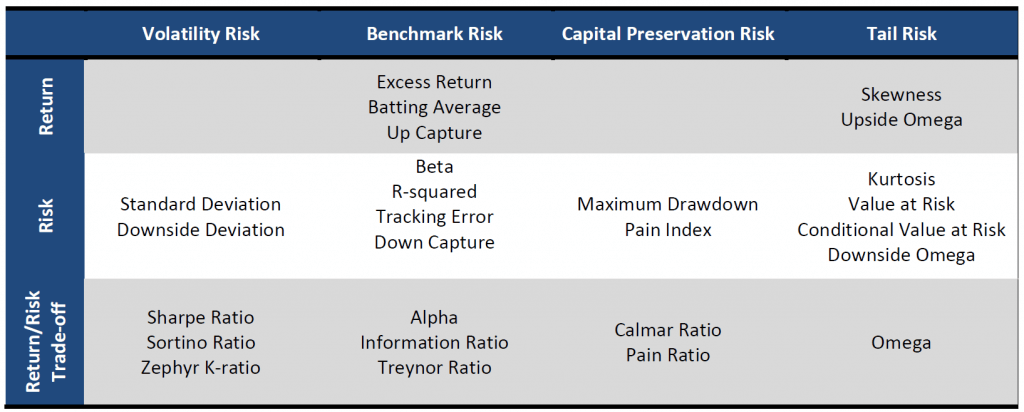When it comes to analyzing the risks and returns of mutual funds, ETFs, SMAs, and hedge funds, financial analysts have an overwhelming number of performance metrics available. If one were to pop open Morningstar Direct, Zephyr StyleADVISOR, or eVestment Analytics, there is a deluge of ratios and statistics available. Sortino ratio, Value-at-Risk, tracking error, kurtosis—who can keep them all straight? What do these metrics tell us? How are they useful?
In a previous role as Director of Research at Zephyr Associates, I developed a framework to organize all the different metrics, so it could be easier for people to understand and keep track of what each metric measures. The framework has two axes: categories of measurement and classifications of risk.
The vast majority of the performance metrics available can be classified in one of three ways:
Generally speaking, the higher or larger the measures of return, the better. Conversely, one hopes the values of the various risk measures to be as small as possible. Finally, since return-vs-risk measures are typically expressed as ratios with return in the numerator and risk in the denominator, one would like to see the trade-off ratios like Sharpe ratio and information ratio to be as large as possible.
The other axis brings in the many ways we understand risk. While volatility risk is the more familiar one, focusing on one aspect risk while ignoring others leaves blind spots in our understanding of it. To provide a holistic view, I propose four broad classifications:
This framework reflects the evolution in thinking over the last 50-60 years. When Harry Markowitz and his contemporaries developed the ground-breaking Modern Portfolio Theory, risk was most often described in terms of volatility. Because investment returns were often described using long-term averages, volatility was used as a cross-check on the validity of those long-term averages. Volatility was the original measure of risk, and it continues to this day as Standard Deviation and Sharpe Ratio are two of the more widespread metrics used to measure and compare funds.
The metrics that fall under benchmark risk are calculated relative to a standard measuring stick to highlight value and performance. During the 1980s and 1990s, the most popular performance metrics were measures like alpha, beta, information ratio, and capture ratios, all which fall under benchmark-relative risk. Why were they so popular during this time? I believe this was for two reasons.
First of all, equity markets enjoyed a remarkable bull run between 1982 and 2000. With the market performing so well, so did everyone else. Second, during this era, passive investing established itself as a viable approach. Vanguard and then later the ETF providers promised to match market returns very affordably rather than potentially outperform at a hefty price. With the bull market and passive investing as a backdrop, it is no wonder that benchmark-driven metrics became popular. If one was an active manager, one had to “prove” added value over a passive option, and metrics like alpha and information ratio are designed to do just that.
The shortcomings of benchmark-relative metrics were exposed during the first decade of the new millennium. In the span of less than ten years, we experienced the two worst bear markets since World War II. During the dot-com bust of 2000-02, markets lost almost 45%, and during the Financial Crisis of 2007-09, markets fell over 50%. In this environment, it was entirely possible that a manager outperformed its benchmark and posted respectable alphas and information ratio but still lost 40% of its value.
When most investors think of risk, simply “not losing money” is the most likely definition. Looking to metrics that can measure this is crucial for those who care more about preserving their wealth that outperforming a benchmark. The idea of maximizing the excess return-vs-tracking error relationship takes a backseat to not losing 30%, 40%, or 50% of your wealth. Ways of quantifying risk in terms of capital preservation represent the next generation in risk and performance measurement. Two of which, Pain Index and Pain Ratio, we have already discussed on this blog.
Closely related to capital preservation is the risk of extreme, outlier events. Commonly known as “tail risk” or “black swan” events, they are marked by their rarity and severity. Despite their “rarity,” it is important to measure how funds do during these extreme events, so investors can be better prepared for when the event may happen. Furthermore, minimizing the impact of these types of events may help avoid the life-altering financial losses that can occur. The scope and scale of the Financial Crisis of 2007-09 had not been seen since the Great Depression, and who can really say what the future will bring. While quantifying tail risk is difficult, there have been some innovations on this front.
When we combine these concepts along two axes, we get what at Zephyr we called “the StatMAP.” Most of the performance and risk metrics fall neatly into this grid.

Source: Swan Global Investments
There are certainly more performance metrics out there, but most of them would fit somewhere within this framework.
With this framework, it should be easier for individuals to pick the metric that best suits what they want to specifically measure and compare when looking at different funds’ performances.
While certain metrics like beta are well established and well understood, many of the newer, higher-level statistics could use a bit of explanation. This is especially true of the newer, post-MPT statistics in the “Capital Preservation” and “Tail Risk” columns that are more useful for analyzing hedge funds and liquid alternatives. We have already discussed Pain Index and Pain Ratio, two favorites here at Swan Global Investments. With a focus on measuring alternative investments, some metrics we will discuss in this series are Omega and Zephyr K-Ratio.

Marc Odo, CFA®, CAIA®, CIPM®, CFP®,Client Portfolio Manager, is responsible for helping clients and prospects gain a detailed understanding of Swan’s Defined Risk Strategy, including how it fits into an overall investment strategy. Formerly, Marc was the Director of Research for 11 years at Zephyr Associates.
[1] The K-ratio was first proposed by Lars Kestner in 1996. The Zephyr K-ratio is a variation of the K-ratio that removes an element of the formula that incorporates the number of data points used in the calculation. http://www.styleadvisor.com/sites/default/files/article/zephyr_concepts_zephyr_k_ratio_pdf_41672.pdf
[2] Because this is a cumulative return graph, it takes into account the compounding of wealth. In order to superimpose a best-fit line over a compounding series, the graph must first be converted to a log scale.
Swan Global Investments, LLC is a SEC registered Investment Advisor that specializes in managing money using the proprietary Defined Risk Strategy (“DRS”). SEC registration does not denote any special training or qualification conferred by the SEC. Swan offers and manages the DRS for investors including individuals, institutions and other investment advisor firms. Any historical numbers, awards and recognitions presented are based on the performance of a (GIPS®) composite, Swan’s DRS Select Composite, which includes non-qualified discretionary accounts invested in since inception, July 1997, and are net of fees and expenses. Swan claims compliance with the Global Investment Performance Standards (GIPS®). The Swan Defined Risk Strategy Select Composite demonstrates the performance of non-qualified assets managed by Swan Global Investments, LLC since inception. It includes discretionary individual accounts whose account holders seek the upside potential of owning stock, and the desire to eliminate most of the risk associated with owning stock. The Composite relies on LEAPS and other options to manage this risk. Individual accounts own S&P 500 exchange traded funds and LEAPS associated with the exchange traded funds as well as multiple other option spreads that represent other indices that are widely traded. The Defined Risk Strategy was designed to protect investors from substantial market declines, provide income in flat or choppy markets, and to benefit from market appreciation. Stock and options are the primary components of the strategy.
All Swan products utilize the Defined Risk Strategy (“DRS”), but may vary by asset class, regulatory offering type, etc. Accordingly, all Swan DRS product offerings will have different performance results due to offering differences and comparing results among the Swan products and composites may be of limited use. All data used herein, including the statistical information, verification and performance reports are available upon request. The S&P 500 Index is a market cap weighted index of 500 widely held stocks often used as a proxy for the overall U.S. equity market. The 60/40 benchmark is a blended composite, weighted 60% in the aforementioned S&P 500 Index and 40% in the Barclays US Aggregate Bond Index to represent balanced portfolios. The Barclays US Aggregate Bond Index is a broad-based flagship benchmark that measures the investment grade, US dollar-denominated, fixed-rate taxable bond market. The index includes Treasuries, government-related and corporate securities, MBS (agency fixed-rate and hybrid ARM pass-throughs), ABS and CMBS (agency and non-agency). HFRI Fund Weighted Composite Index: The HFRI Fund Weighted Composite Index is a global, equal-weighted index of over 2,000 single-manager funds that report to HFR Database. Constituent funds report monthly net of all fees performance in US Dollar and have a minimum of $50 Million under management or a twelve (12) month track record of active performance. The HFRI Fund Weighted Composite Index does not include Funds of Hedge Funds.
Indexes are unmanaged and have no fees or expenses. An investment cannot be made directly in an index. Swan’s investments may consist of securities which vary significantly from those in the benchmark indexes listed above and performance calculation methods may not be entirely comparable. Accordingly, comparing results shown to those of such indexes may be of limited use. The adviser’s dependence on its DRS process and judgments about the attractiveness, value and potential appreciation of particular ETFs and options in which the adviser invests or writes may prove to be incorrect and may not produce the desired results. There is no guarantee any investment or the DRS will meet its objectives. All investments involve the risk of potential investment losses as well as the potential for investment gains. Prior performance is not a guarantee of future results and there can be no assurance, and investors should not assume, that future performance will be comparable to past performance. All investment strategies have the potential for profit or loss. Further information is available upon request by contacting the company directly at 970–382-8901 or www.www.swanglobalinvestments.com. 191-SGI-051018